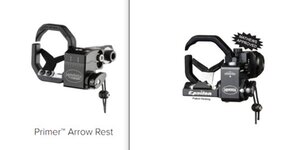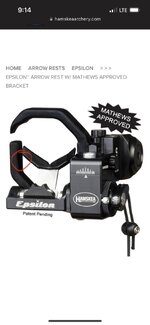BoilerBowHunter
WKR
- Joined
- Sep 13, 2020
- Messages
- 1,033
When considering limb flex you will notice that the limb tip is the location with the most travel through the draw cycle. The amount of distance traveled will decrease as you move further from the limb tip and towards the limb pocket. When choosing where to attach the activation cord, the main thing to consider is the total movement of that specific location though the draw cycle. As the attachment point goes towards the limb tip, the arrow will be guided for a longer period of time. Where as the further the attachment point moves away from the limb tip, the shorter period of time the launcher will be guiding the arrow.
There is a certain amount of movement required for the activation cord to go slack and the launcher to come up to a repeatable position. For the Hybrid/Trinity Hunter we have found that about .5" of movement is required just for the launcher to hit the full upright position with a 1/8" preload on the Dampening Coil Spring or Rebound Dampener. After this point, any additional movement of the attachment point will result in distance that the launcher is guiding the arrow through the shot cycle before the launcher begins to fall. We recommend having the launcher guide the arrow for about 50-70% of the shot cycle or power stroke for the best accuracy. For 50% guidance, the attachment point would have to move about 1" through the shot cycle.
The easiest way that I have found to figure out the optimal attachment point is by marking an arrow and calculating the guidance that way. Here are the steps I take.
1. Measure the Power Stroke: With the activation cord disconnected and the launcher in the upright position, nock an arrow and let it set on the launcher. Put a mark on the top of the arrow at the location where arrow is touching the launcher. Using a draw board, bring the bow to full draw and mark the arrow where the launcher is now making contact. The distance between these two marks is the power stroke or distance the arrow is pulled back during the draw cycle.
2. Calculating the Desired Guidance: We want the launcher to guide the arrow for 50-70% of the power stroke. I find the best results for hunting closer to 50%. Since you know the distance of the power stroke, you can calculate the distance for a desired amount of guidance. For example, 50% guidance over a 22" power stroke would 11" of guidance. In this example, you would want the launcher to be in the full upright position for the last 11" of the power stroke. Mark this location on the same arrow used to measure power stroke so that you have a reference for the next steps.(you can mark both the 50% and 70% location so that you know you are in the acceptable range.
3. Dialing In the Optimal Attachment Location: Tie the activation cord around the limb(don't apply the knobby limb pad yet) and apply the recommend tension to the cord. Next, nock the arrow and rest it on the launcher that is currently in the down position. Using the draw board, draw the bow to the point that the launcher just barely reaches the full upright position and reference where the launcher is contacting the arrow in relation to the marks you have just placed on the arrow. If the launcher has not yet reached the mark for the desired guidance, then you will need to move the activation cord in the direction of the limb tip. If the launcher is past the mark for the desired guidance, then you will need to move the activation cord further from the limb tip. Bring the bow back to the brace position and move the activation cord as needed making sure to properly set the tension on the activation cord each time. Repeat this step until the launcher is guiding the arrow for the desired amount of time.
4. Mark the Location and Install the Knobby Limb Pad: Using a pencil, mark the location of the activation cord that you found gives the desired amount of guidance and then move the cord out of the way.(the pencil mark can later be wiped off) Next, install the knobby limb pad with the center of the pad in line with the pencil mark. Re-install the activation cord with the the cord crossing through the center groove set of the knobby limb pad. Apply the proper amount of tension to the activation cord and enjoy shooting with your properly timed arrow rest.
Just let me know if you have any questions on this process.
@devinhal Im just getting a new Epsilon setup on a VXR and had a few questions for you.
I don’t have access to a draw board. I saw you recommended 2-2.5” from the limb tip on the V3 and V3X. Would you recommend the same for the VXR?
I saw the instructions reference more guidance on the Hamskea website. I can’t seem to locate that. Is there a video or something that talks about tension cord placement?
One last question about the nock point. I know QADs like ~1/8” nock high. Is there a recommendation for the Epsilon?



